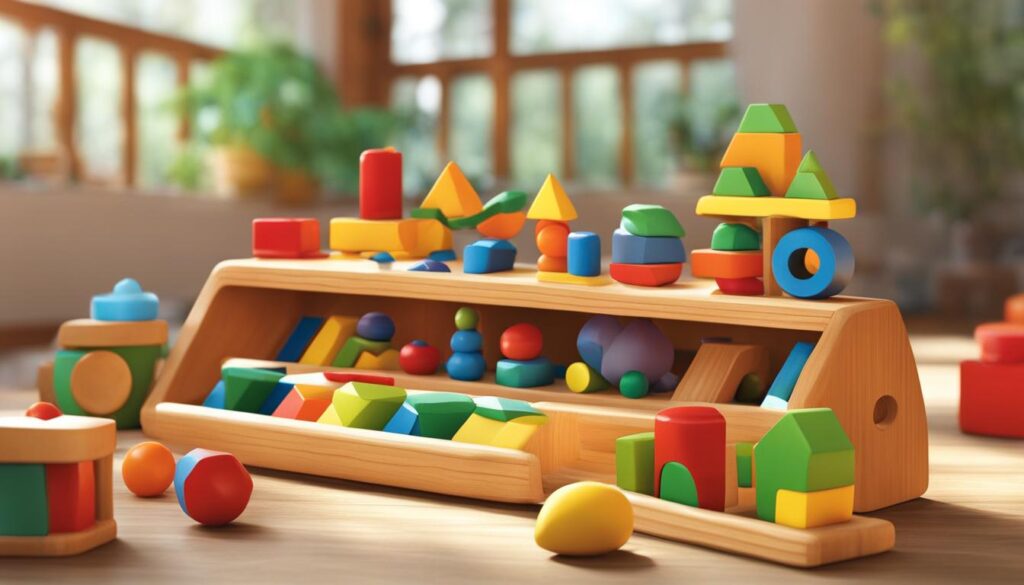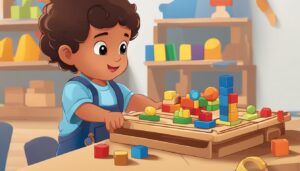Welcome to our article on Montessori toys and their unique approach to color. If you’ve ever wondered why Montessori toys tend to have a more muted color palette or even no color at all, you’re not alone. In this article, we delve into the concept behind the colorless nature of Montessori toys and the benefits they provide for children’s learning and development.
Montessori schools and educators follow a philosophy that emphasizes calm, muted colors and items that reflect real-world, natural beauty. The intentional use of neutral colors in Montessori environments promotes concentration and serenity, creating a peaceful learning space for children.
Montessori toys are designed with specific color schemes catering to different developmental stages. For example, high-contrast black and white imagery is often used for infants, aiding in their visual discrimination skills. The focus is on creating an environment that supports calmness, concentration, and the child’s ability to engage deeply in their learning process.
While color is indeed important in Montessori materials, it is not the sole determining factor for a toy to be considered Montessori-aligned. Rather, the emphasis is on creating a calm and uncluttered space that supports the child’s learning and development, allowing them to focus on the task at hand.
Key Takeaways:
- The use of calm, muted colors in Montessori toys promotes concentration and serenity.
- Montessori toys are designed with specific color schemes for different developmental stages.
- The emphasis is on creating a calm and uncluttered space that supports the child’s learning and development.
- Color is important in Montessori materials, but it is not the sole determining factor for a toy to be considered Montessori-aligned.
- Montessori toys aid in the child’s visual discrimination and promote calmness and concentration.
Now that we’ve explored the color concept of Montessori toys, let’s take a closer look at the philosophy behind these colorless toys and their significance in Montessori education.
The Philosophy Behind Colorless Montessori Toys
The Montessori philosophy advocates for simplicity and minimalism in both the physical environment and the selection of toys within the classroom. Colorless Montessori toys, devoid of vibrant hues, play a crucial role in supporting child development through open-ended play, independence, and sensory exploration.
Colorless Montessori toys are crafted from natural materials, including wood, metal, and fabric. These materials provide sensory-rich experiences, connecting children with the real world and promoting a deeper understanding of their surroundings.
The intentional design of Montessori toys encourages hands-on learning, allowing children to explore and express their creativity in a self-directed manner. By minimizing distractions and utilizing neutral colors, these toys help foster focus, concentration, and a sense of calmness in the child’s play environment.
Montessori toys without colors are powerful tools for supporting cognitive development, fine and gross motor skills, and sensory stimulation. They promote independent thinking, problem-solving abilities, and the honing of various skills vital for a child’s overall growth.
In the Montessori approach, the absence of bright colors allows children to focus on the inherent qualities and functionality of each toy, rather than being influenced by external stimuli. This deliberate design choice encourages children to engage with the toys in a meaningful and purposeful way, leading to enhanced learning experiences.
The role of monochrome toys in Montessori education cannot be overstated. These colorless toys provide an environment that is conducive to concentration, exploration, and the development of essential skills, setting the stage for a holistic educational journey.
Contrasting Montessori Toys with Traditional Toys

When it comes to choosing toys for your child, understanding the differences between Montessori toys and traditional toys is essential. Montessori toys are designed with a clear focus on educational value, while traditional toys often prioritize entertainment. Let’s explore the distinctions between these two types of toys.
The Purposeful Design of Montessori Toys
Montessori toys are intentionally crafted to promote learning, independence, and skill development in children. These toys are made from natural materials, such as wood, and have a thoughtful design that engages children in purposeful play. The use of natural materials provides sensory-rich experiences and connects children with the real world. Montessori toys support cognitive development, fine and gross motor skills, and concentration.
The Allure of Traditional Toys
On the other hand, traditional toys offer a wide variety of materials, colors, and designs to appeal to popular trends and provide entertainment. They focus on immediate fun rather than intentional educational design. Traditional toys can be found in vibrant colors and feature flashy lights, sounds, and other attention-grabbing elements.
Choosing the Right Toys for Your Child
The choice between Montessori toys and traditional toys ultimately depends on your individual goals and values as a parent or caregiver. If you prioritize educational value and want toys that support your child’s development across various skills, Montessori toys are an excellent choice. However, if you are looking for toys that solely provide entertainment and amusement, traditional toys may be more suitable.
| Montessori Toys | Traditional Toys |
|---|---|
| Promote learning, independence, and skill development | Focus on entertainment and immediate fun |
| Use natural materials and purposeful design | Offer a wide variety of materials, colors, and designs |
| Support cognitive development, fine and gross motor skills, and concentration | Primarily provide amusement and entertainment |
The Benefits of Montessori Toys
Montessori toys provide numerous advantages for your child’s development. These toys encourage hands-on learning, fostering independence and problem-solving skills. By engaging in interactive play with Montessori toys, your child has the opportunity to explore, experiment, and discover the world around them, resulting in a deeper understanding of concepts and improved cognitive abilities.
Montessori toys are specifically designed to promote cognitive skills, fine and gross motor skills, and sensory stimulation. The use of natural materials like wood and fabric not only enhances the sensory experience but also connects your child with the real world. The sensory-rich environment created by these toys contributes to their overall cognitive development and helps refine their motor skills.
One of the key benefits of Montessori toys is their ability to foster concentration and focus in children. These toys are intentionally designed to minimize distractions and offer open-ended play opportunities, encouraging your child to fully engage and concentrate on the task at hand. This focused play allows them to develop their attention span and enhance their ability to concentrate on other activities as well.
In addition to promoting concentration, Montessori toys also encourage independent play. They provide your child with the freedom to explore and use their creativity, stimulating their imagination and problem-solving abilities. By engaging in independent play with Montessori toys, your child will gain confidence, develop decision-making skills, and become more self-reliant.
FAQ
Q: Why don’t Montessori toys have color?
A: Montessori toys emphasize calm, muted colors to promote concentration and serenity in the learning environment. The use of neutral colors helps reduce distractions and supports the child’s focus and concentration.
Q: What is the philosophy behind colorless Montessori toys?
A: Colorless Montessori toys promote open-ended play, independence, and sensory stimulation. They are made from natural materials and have a purposeful design to engage children in purposeful learning experiences.
Q: How do Montessori toys differ from traditional toys?
A: Montessori toys are intentionally designed to promote learning and skill development, while traditional toys focus primarily on entertainment. Montessori toys use natural materials and have a purposeful design, while traditional toys come in various materials and designs to appeal to popular trends.
Q: What are the benefits of Montessori toys?
A: Montessori toys offer a range of benefits, including promoting cognitive development, fine and gross motor skills, and sensory stimulation. They foster concentration and focus, support independent play, and encourage problem-solving skills and creativity.




